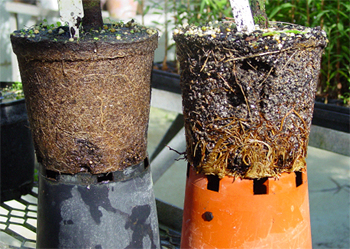|
Air supplies plants with carbon dioxide (CO2) and oxygen (O2). Through the process of
photosynthesis plants utilise light to synthesise carbohydrates (food) from
carbon dioxide, absorbed through pores (stomata) in the leaves, and water.
Carbon dioxide is sufficiently abundant in the atmosphere for normal growth of plants.
Carbon dioxide enrichment of the atmosphere surrounding plants, combined with optimisation of other plant requirements, has been used in the plant nursery industry to increase plant quality and growth rate. However, this technique is unlikely to be useful for growing test plants.
Through the process of respiration, oxygen is combined with carbohydrates and nutrients to produce new cells and repair damaged ones, thus enabling plants to grow. Oxygen is absorbed through most plant parts and is critical to all tissue, particularly plant roots. Deficiency of
oxygen in roots is caused by the following factors:
 | waterlogging, where all pores in the medium are filled with water for prolonged
periods,
|
 | compacted potting mix or potting mix with a high proportion of very fine particles constituting a physical barrier to
oxygen diffusion into the mix,
|
 | organic decomposition in a potting mix that is high in organic matter producing methane which fills pore spaces preventing
oxygen entry, and
|
 | high microbial activity in the potting mix producing high levels of carbon
dioxide which replaces the air in pores. |
In severe cases of oxygen deficiency roots die, resulting in death of the plants. Most plants under stress probably have some ability to translocate
oxygen, but growth is less than if oxygen was absorbed directly by the roots from air in the potting mix
(Handreck and Black
1984).
 |
 |
|
A compacted root mass (caused
by severely root bound plants) and/or
poor quality media, (usually due to a high percentage of
fine particles), often results in the pooling of water, after
irrigation, on the top of potting media. Permeability is low and
consequently, aeration and drainage is also very poor. Liverworts,
algae and mosses often flourish on the waterlogged surface,
further exacerbating the problem. These conditions are conducive
to disease development. The stressed plant rapidly loses vigour,
making it more susceptible to pest attack. Such plant specimens
need to be root pruned and re-potted into a well aerated media or
discarded if surplus to needs. |
On the left is a densely
packed ball of fine, brown roots. There is an obvious lack of
coarse media particles that would facilitate water infiltration
and drainage and good aeration. The waterlogged media caused many
of the roots to rot and go brown in coloration. When the root mass
of plants, besieged with this problem, is removed from itsí pot,
it is usually characterised by the pungent smell of rotting
vegetative matter. In contrast, the media of the plant on the
right shows an abundance of coarse particles, a less packed root
mass, vigorous and healthy yellow/white roots, and it released a
pleasantly sweet odour, when removed from its container.
|
Aquatic plants are able to supply their roots with
oxygen brought down from their leaves through special stem cells
(See Aquatic Plant
Propagation).
[ Back ] [ Next ]
Gio. W. Fichera
|
|

